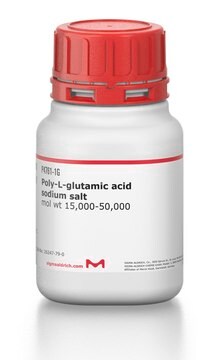P3418
Poly-(α,β)-DL-aspartic acid sodium salt
mol wt 2,000-11,000
Sinónimos:
Aspartic acid homopolymer sodium salt
About This Item
Productos recomendados
formulario
powder
mol peso
2,000-11,000
color
white to off-white
temp. de almacenamiento
−20°C
¿Está buscando productos similares? Visita Guía de comparación de productos
Aplicación
- Improving the effectiveness of (-)-epigallocatechin gallate (EGCG) against rabbit atherosclerosis by EGCG-loaded nanoparticles prepared from chitosan and polyaspartic acid.: This research highlights the development of nanoparticles using polyaspartic acid to enhance the bioavailability and therapeutic effect of EGCG in treating atherosclerosis (Hong et al., 2014).
- Polyaspartate, a biodegradable chelant that improves the phytoremediation potential of poplar in a highly metal-contaminated agricultural soil.: The study evaluates the use of polyaspartate in enhancing the phytoremediation capabilities of poplar trees, showcasing its environmental application for soil decontamination (Lingua et al., 2014).
- Modulation of calcium oxalate dihydrate growth by selective crystal-face binding of phosphorylated osteopontin and polyaspartate peptide showing occlusion by sectoral (compositional) zoning.: This research investigates the role of polyaspartate in modulating the growth of calcium oxalate crystals, with implications for understanding kidney stone formation (Chien et al., 2009).
Nota de preparación
Nota de análisis
Otras notas
Código de clase de almacenamiento
11 - Combustible Solids
Clase de riesgo para el agua (WGK)
WGK 3
Punto de inflamabilidad (°F)
Not applicable
Punto de inflamabilidad (°C)
Not applicable
Certificados de análisis (COA)
Busque Certificados de análisis (COA) introduciendo el número de lote del producto. Los números de lote se encuentran en la etiqueta del producto después de las palabras «Lot» o «Batch»
¿Ya tiene este producto?
Encuentre la documentación para los productos que ha comprado recientemente en la Biblioteca de documentos.
Artículos
Humankind has utilized protein materials throughout its existence, starting with the use of materials such as wool and silk for warmth and protection from the elements and continuing with the use of recombinant DNA techniques to synthesize proteins with unique and useful properties.
Nuestro equipo de científicos tiene experiencia en todas las áreas de investigación: Ciencias de la vida, Ciencia de los materiales, Síntesis química, Cromatografía, Analítica y muchas otras.
Póngase en contacto con el Servicio técnico








